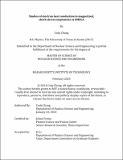Studies of electron heat conduction in magnetized, shock-driven implosions at OMEGA
Author(s)
Chang, Cody
DownloadThesis PDF (7.433Mb)
Advisor
Frenje, Johan
Terms of use
Metadata
Show full item recordAbstract
Imposing an external magnetic field strong enough to magnetize the plasma is currently being researched as an advanced approach to inertial confinement fusion (ICF). The electron heat conduction, one of the primary hot spot energy losses, is suppressed perpendicular to the external magnetic field, which is expected to increase yields and temperatures in collisional plasmas. However, since the particle and energy transport are restricted in one out of three dimensions in the plasma, it will naturally tend to develop a mode-2 asymmetry. This has been observed in experiments and in simulations, which display a volume increase of the hot spot that decreases its pressure and, thus, yield, one of the most important parameters in an ICF experiment.
This thesis discusses an experiment performed at the OMEGA laser facility to further explore the impact of a 25 and 50 T seed magnetic field on the performance of a shock-driven, direct-drive ICF implosion with an asymmetric drive. In these experiments, measurements of the hot spot asymmetry at bang time indicate a 4.75x P2/P0 enhancement when magnetized with a 50 T initial field. Time-resolved measurements of the shell trajectory, however, indicated no asymmetry enhancement, indicating that the shell plasma is not sufficiently magnetized for the magnetic field to have an effect. Gorgon simulations, however, predicted an enhanced asymmetry due to magnetization of the shell and, thus, suppressed electron thermal conductivity. Additionally, the observed hot spot electron temperature was enhanced by 1.6x for both 25 and 50 T magnetic field strengths relative to the unmagnetized temperature. Simulations also predicted an enhanced electron temperature, but also expected the 50 T case to be higher than the 25 T case, with the 50 T case expected to have a 57% electron temperature enhancement and the 25 T enhanced by 38%. The factor by which experimental magnetized electron temperatures at 25 T and 50 T increased by agreed more with the simulated 50 T. This could indicate that the simulations are underpredicting how magnetized the 25 T hot spot becomes, which is difficult to assess since magnetization cannot be directly measured experimentally. Additionally, a lower DD ion temperature was observed with a magnetic field, with the 50 T having on average a 0.8 keV and 25 T a 0.9 keV decrease compared to the 0 T shots.
Finally, the loss of nuclear yield is discussed. A 28% increase in volume of the magnetized hot spot was observed. This implies a loss of density, an important quantity in determining a plasma’s yield. No change in the inferred pressure was measured, however.
Date issued
2024-02Department
Massachusetts Institute of Technology. Department of Nuclear Science and EngineeringPublisher
Massachusetts Institute of Technology